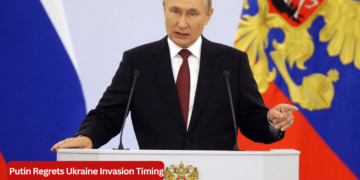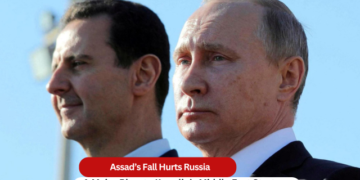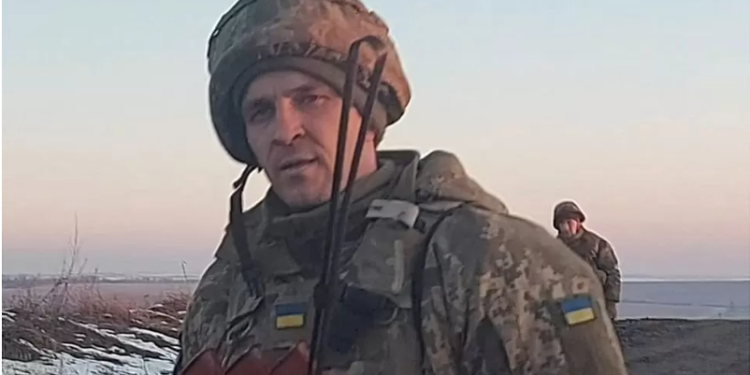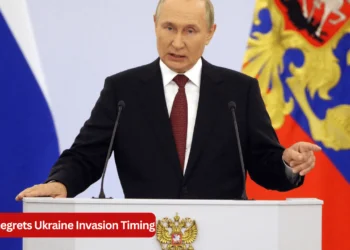Lieutenant-colonel Pavel Kuzin positioned himself at the machine gun as the lone soldier still able to battle. Everyone else in his unit lay injured or deceased.
The 37-year-old, suffering from shell shock and sporting a bandaged arm, fired upon the waves of Russian soldiers attempting to assault his position. They made no attempt to conceal themselves and simply approached him across the open field.
Pavel knew he couldn’t maintain the position for long, but he needed to buy time until a rescue team arrived. His final act was to guarantee the safety of his injured comrades.
According to the Ukrainian military, Bakhmut is now the site of numerous “unprecedentedly bloody” battles, where they must now repel up to 50 daily assaults on their positions. Russia has amassed vast forces in this region, and their brutal strategy of launching human wave attacks enables them to advance slowly at a high price.
Pavel was in command of a group of six Ukrainian soldiers serving as forward observers. On 17 February, shortly after beginning their watch, they were subjected to intense bombardment. A tank started to bombard their position.
In contrast to the mortar fire, the tank’s aim was chillingly precise. The shells were impacting within a few metres of their trenches. Two disabled soldiers were instructed by Pavel to enter a dugout. A combat physician was dispatched to treat their wounds and prepare them for evacuation. Moments later, a shell struck the timber shelter directly.
“There was a bright flash,” a wounded combatant with the call sign Tsygan reported to the BBC. “I was propelled with such force onto the logs that it nearly crushed me. I could not determine whether I was alive or deceased. Someone was shouting, and the sound appeared to be emanating from 100 metres away.”
It was Pavel’s voice that inquired about their status. The second soldier was partially concealed beneath dirt and logs. He had died.
Tsygan was so weak that Pavel had to drag him over the splintered timbers blocking the path. It was excruciatingly sluggish to move Tsygan a few metres away into an adjacent trench. When the bombardment temporarily ceased, Pavel returned to search for others.
Two minesweepers arrived to remove the fallen trees and locate the bodies. However, yet another shell struck the dugout, murdering one and injuring the other. The tank continued firing.
At that moment, Russian forces began an assault on their position. Pavel summoned a support unit to evacuate the wounded, then hurried back to his Browning machine gun to repel the Russian infantry.
Pavel served in the 206th Battalion, which fought in the southern Kherson and northeastern Kharkiv regions. But the conflicts over Bakhmut were unlike anything they had previously experienced.
According to platoon commander Mykola Hlabets, the intensity of the battle to breach our positions was startling. “At times, [Russian soldiers] came within 20 metres of us, burrowing and moving across an open field or along a treeline. This is where we fought our first gun battles so close together.”
“They would simply stand and saunter without cover towards our positions. We eliminated one group after another, but they continued to advance.
They were described as a suicide squad by Hlabets. Others refer to them as ammunition.
A number of videos of newly mobilised Russian soldiers appealing to President Vladimir Putin and the authorities to stop “illegal orders” to dispatch them “to be slaughtered” have been shared recently on Telegram channels.
Last month, soldiers from Belgorod stated in a video that they were sent on an assault mission without adequate instruction. After enduring heavy losses, they stated that they would not comply with orders.
According to reports, these poorly trained soldiers are frequently compelled to advance. The assault group Storm of the 5th Brigade of the Russian army stated in a video appeal that they were unable to abandon their position due to zagryad otryad, or blocking troops. Blocking troops are detachments that initiate fire on their own soldiers who attempt to retreat.
These wave attacks resemble the tactics employed during World War I, when soldiers charged the adversary and engaged in close combat. And despite their lack of training and experience, Russia is achieving some success by dispatching newly recruited soldiers on such assaults, albeit at a very high cost.
When opening fire to repel these assaults, Ukrainians expose their positions. As was the case with Pavel’s post, this enables the Russian artillery to identify the target and eliminate it.
In addition, soldiers in forward positions run out of ammunition as they attempt to repel multiple surge attacks. They become an accessible target as a result.

A number of videos of newly mobilised Russian soldiers appealing to President Vladimir Putin and the authorities to stop “illegal orders” to dispatch them “to be slaughtered” have been shared recently on Telegram channels.
Last month, soldiers from Belgorod stated in a video that they were sent on an assault mission without adequate instruction. After enduring heavy losses, they stated that they would not comply with orders.
According to reports, these poorly trained soldiers are frequently compelled to advance. The assault group Storm of the 5th Brigade of the Russian army stated in a video appeal that they were unable to abandon their position due to zagryad otryad, or blocking troops. Blocking troops are detachments that initiate fire on their own soldiers who attempt to retreat.
These wave attacks resemble the tactics employed during World War I, when soldiers charged the adversary and engaged in close combat. And despite their lack of training and experience, Russia is achieving some success by dispatching newly recruited soldiers on such assaults, albeit at a very high cost.
When opening fire to repel these assaults, Ukrainians expose their positions. As was the case with Pavel’s post, this enables the Russian artillery to identify the target and eliminate it.
In addition, soldiers in forward positions run out of ammunition as they attempt to repel multiple surge attacks. They become an accessible target as a result.
As he raced to his Browning machine gun, Pavel was fully aware of this danger. As long as he continued firing, however, his wounded comrades had a chance of being rescued.
Tsygan was bleeding in the trench where Pavel abandoned him, where he was left by Pavel. His pelvis was crushed by shrapnel. A second fragment had pierced his thigh, and a third had struck his abdomen, “flipping the internal organs inside out,” he said. He was only just cognizant.
“I didn’t see much, it was all white,” he stated. I laid on the wintry ground for two hours without experiencing any discomfort.
He was joined by another wounded soldier. As shelling resumed, the rescue crew on an armoured personnel carrier hurriedly rescued them. Tsygan states that they didn’t even have time to close the hatch.
At that point, Pavel’s machine gun ceased firing. A fragment of shrapnel had pierced his helmet and caused his death.
The commanders of the 206th battalion decided to dispatch a team to recover Pavel and the other fallen soldiers.
The following evening, three parties of two soldiers departed to return the bodies.
“The plan looked good on paper, but things quickly went awry,” recalls junior sergeant Vasyl Palamarchuk of the leading group. They became disoriented and almost dashed into Russian positions in the darkness. As they approached the dugout, the Russians spotted them and began firing from a tank.
During those days, Russian tanks and artillery had incessantly bombarded that post, while the Ukrainian heavy artillery had largely remained silent. The reason was a severe shell shortage.
“Once, we counted that the Russians had fired up to 60 shells per day, whereas we could only allow two,” explains Palamarchuk. They decimated trees and everything else, leaving you nowhere to conceal.
The Ukraine struggles to locate ammunition for its artillery from the Soviet era. Receiving ammunition for weapons donated by Ukraine’s western partners is restricted. Recently, Jens Stoltenberg, the secretary general of the NATO military alliance, stated, “Ukraine’s current rate of ammunition expenditures is many times our current rate of production.”
The group of Palamarchuk ultimately recovered Pavel’s body just a few hours before Russian troops occupied the area. The heavy snow changed to frigid rain. After numerous stops on the way back and tunnelling through shell-made craters, they eventually arrived. The entire operation spanned just one kilometre and took six hours.
The entire battalion convened at the evacuation point after midnight to pay their respects to Pavel, who was survived by his wife and daughter.
“It was a huge loss for our unit,” says Palamarchuk. “He died after saving two individuals.”














































